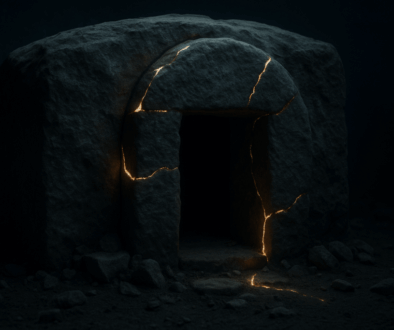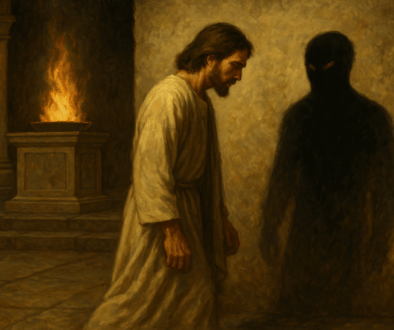Learning to Shudder: Awakening the Body, Healing the Soul
What if the trembling you’ve been taught to fear is actually the doorway to healing, worship, and wonder? This post explores the mythic, psychological, and biblical power of shuddering — not as a weakness, but as a sacred return.
There’s an old fairy tale — retold by the Brothers Grimm — about a boy who doesn’t know how to shudder. Everyone else jumps at fear, flinches at shadows, feels. But not him. He’s untouched, unmoved. He says, again and again, “If only I could learn to shudder…”
We might call him brave. But he’s not. He’s numb. Dissociated. His body doesn’t tremble because it no longer knows how.
And so, the story is not about becoming fearless — it’s about becoming fully alive. It’s about learning to experience what we might call the holy shudder.
The Mythic Path: Hermes and Dionysus
In mythic terms, the boy’s journey is one of initiation into feeling. He is guided by archetypal forces: Hermes, the guide between worlds, who teaches him to navigate the dead logic of disconnection — and Dionysus, the wild god of ecstasy and madness, who opens the gates of his nervous system and teaches him to shudder.
Dionysus, grandson of the Titans, doesn’t gently explain emotion. He overwhelms. He pours the wine. He tears the veil. He brings the tremble back to the body.
To learn to shudder is to return to the temple of the body, after a long exile (1 Cor 6:19).
Shuddering and the Nervous System
In trauma work, we now understand what the myth and the body always knew: healing often begins when the body shakes, sobs, releases. When we begin to feel again, we often shudder.
“Dissociation is the essence of trauma.” — Bessel van der Kolk, The Body Keeps the Score
“You can be fully in charge of your life only if you can acknowledge the reality of your body, in all its visceral dimensions.” — Bessel van der Kolk
“Regulation moves back to the body, but this time emphasizing how you can use physical activities, such as breathing and muscles, to shift to a more calm and relaxed state.” — Linnea Passaler, Heal Your Nervous System
Modalities like TRE (Tension & Trauma Releasing Exercises), yoga, and somatic experiencing all revolve around this principle: when the body begins to shake, it’s not malfunctioning. It’s healing.
It’s thawing from freeze.
It’s remembering itself.
And yet — this awakening is not just physiological. It’s spiritual.
This, too, is the holy shudder.
When God Feels Far Away
(I explore this feeling more deeply in my companion post: When God Feels Distant.)
One of trauma’s cruelest effects is that it doesn’t just separate us from others — it can even separate us from God. When our body is locked in a freeze or high-stress state, the soul often feels muted. We know God is near — but we can’t feel Him.
We are like the dry bones in Ezekiel’s vision — disconnected, scattered, lifeless.
But then:
“There was a noise, a rattling sound, and the bones came together, bone to bone… and breath entered them; they came to life and stood up.” — Ezekiel 37:7–10
The shudder comes first. The rattling. The body remembering how to feel. Then — breath. Spirit. Life.
To tremble is not to fall apart. It’s to come back together.
Trembling in the Sight of God
Far from being a problem, trembling is biblical. It is the body’s response to awe, to beauty, to truth.
“Work out your salvation with fear and trembling, for it is God who works in you.” — Philippians 2:12–13
Even Jesus, in the garden of Gethsemane, entered a state of total-body anguish. The Gospel says:
“Being in anguish, he prayed more earnestly, and his sweat was like drops of blood falling to the ground.” — Luke 22:44
The text doesn’t say he shuddered, but the image of sweating blood implies a profound somatic experience — overwhelming stress, surrender, and grief coursing through the body.
Jesus didn’t suppress emotion. He allowed it to move through his body. To feel fully was part of his path.
The biblical witness doesn’t ask us to suppress emotion. It asks us to embody worship — to let awe and grief and love move through us, even shake us. This is not immaturity. It is reverence. It is truth.
This, too, is the holy shudder.
The Holy Shudder
To learn to shudder is not just to heal trauma — it is to recover wonder.
“I tremble in awe of you.” — Psalm 119:120
It is to feel the nearness of God again. To let the breath return to dry bones. To reclaim the sacred union of body and Spirit.
So when the shaking comes — let it. When the sobs rise — stay with them. When your hands tremble or your knees go weak, don’t rush to stop it. You are not falling apart.
The shudder is rediscovering what’s real, utterly necessary to heal from dissociation and trauma. See my post here about dissociation from self and reality.
You are coming alive.
This is the holy shudder.



